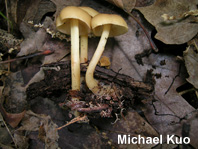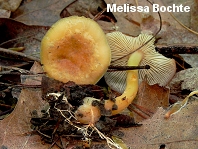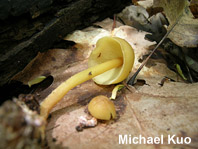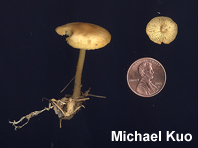| Major Groups > Gilled Mushrooms > Pale-Spored > Collybioid > Gymnopus subsulphureus |

|
Gymnopus subsulphureus [ Basidiomycetes > Agaricales > Marasmiaceae > Gymnopus . . . ] by Michael Kuo This member of the Gymnopus dryophilus species group is probably the easiest one to recognize; it features a yellow cap, yellow gills, and pinkish rhizomorphs. Additionally, it appears in spring (usually during or just after morel season) and is limited to hardwood forests east of the Rocky Mountains. Mating studies by Vilgalys and Miller (1983) determined that Gymnopus subsulphureus is indeed distinct from Gymnopus dryophilus--but a later study (Vilgalys, 1991) found that our North American Gymnopus subsulphureus is able to "mate" with the European Gymnopus alpinus, despite fairly substantial differences in physical appearance; therefore the most correct name for the mushroom featured here might be "Gymnopus alpinus ssp. subsulphureus." Collybia subsulphurea is a synonym, as is Collybia virginiana. Description: Ecology: Saprobic; growing alone, scattered, or gregariously; spring; fairly widely distributed east of the Rocky Mountains. Cap: 1-4 cm; convex, becoming planoconvex; bald; moist; pale to bright yellow; fading markedly as it dries out to buff or yellowish, often passing through a two-toned stage. Gills: Attached to the stem narrowly; very crowded; yellow to yellowish (rarely nearly white). Stem: 2-10 cm long; up to about 7 mm thick; more or less equal, with a small basal bulb; dry to greasy; hollow; bald except for whitish fuzz near the base; yellow; base attached to pinkish rhizomorphs. Flesh: Thin; whitish to yellowish. Odor and Taste: Odor not distinctive; taste mild or slightly bitter. Chemical Reactions: KOH negative on cap surface. Spore Print: White. Microscopic Features: Spores: 5-6.5 x 2.5-3.5 µ; smooth; elliptical; inamyloid. Pleurocystidia absent or inconspicuous. Cheilocystidia up to about 40 µ long and 2-6.5 µ wide; variously shaped; often with protrusions or lobes; filamentous. Pileipellis a tangle of cylindric, branching (but not diverticulate or coralloid) hyphae 3-12 µ wide. REFERENCES: (Peck, 1907) Murrill, 1916. (Saccardo, 1912; Kauffman, 1918 [as Collybia aquosa]; Vilgalys & Miller, 1983; Vilgalys, 1991.) Herb. Kuo 05059501, 05059502, 05089503, 05020602, 04280703, 05050702, 05150801. This website contains no information about the edibility or toxicity of mushrooms. |
© MushroomExpert.Com |
|
Cite this page as: Kuo, M. (2013, January). Gymnopus subsulphureus. Retrieved from the MushroomExpert.Com Web site: http://www.mushroomexpert.com/gymnopus_subsulphureus.html |




